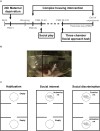Effects of Maternal Deprivation and Complex Housing on Rat Social Behavior in Adolescence and Adulthood
- PMID: 30254573
- PMCID: PMC6141926
- DOI: 10.3389/fnbeh.2018.00193
Effects of Maternal Deprivation and Complex Housing on Rat Social Behavior in Adolescence and Adulthood
Abstract
Early life context and stressful experiences are known to increase the risk of developing psychiatric disorders later in life, including disorders with deficits in the social domain. Our study aimed to investigate the influence of early life environment on social behavior in a well-controlled animal model. To this end we tested the effects of maternal deprivation (MD) on rat social play behavior in adolescence and social interaction in adulthood. Additionally, we provided a stimulating environment during adolescence (complex housing) as a potential intervention to diminish the effects of early life stress. Male and female Wistar rats were deprived from their mother for 24 h on postnatal day 3 (PND 3) or were left undisturbed. Complex housing started 5 days after weaning and consisted of housing 10 same-sex conspecifics in large, two-floor MarlauTM cages until the end of the study. Social play behavior in adolescence was tested under different conditions (3 h vs. 24 h social isolation prior to testing). Maternally deprived males - but not females - showed a longer latency to play and a decreased total amount of social play behavior, after a 24 h isolation period. In adulthood, social discrimination was impaired in deprived male and female rats in the three-chamber social approach task. Complex housing did not moderate the effects of MD, but in itself induced a strong behavioral phenotype. Both complex housed males and females hardly displayed any play behavior after a 3 h isolation period. However, after 24 h of isolation, these animals showed shorter latencies to engage in social play behavior. Only complex housed males truly showed more social play behavior here, while showing less social interest in adulthood. We conclude that MD has mild negative effects on social behavior in adolescence and adulthood, which are not counteracted by complex housing. Complex housing induces a specific phenotype associated with rapid habituation; a lack of social play after short isolation periods, while increasing play behavior after a prolonged period of isolation in adolescence, and less social interest, paired with intact social discrimination in adulthood. In both early life settings, males seem to be more influenced by the early life environment compared to females.
Keywords: behavior; complex housing; early life stress; environmental enrichment; maternal deprivation; social play; three-chamber social approach task.
Figures





Similar articles
-
Complex Living Conditions Impair Behavioral Inhibition but Improve Attention in Rats.Front Behav Neurosci. 2015 Dec 24;9:357. doi: 10.3389/fnbeh.2015.00357. eCollection 2015. Front Behav Neurosci. 2015. PMID: 26733839 Free PMC article.
-
Testing the cumulative stress and mismatch hypotheses of psychopathology in a rat model of early-life adversity.Physiol Behav. 2012 Jul 16;106(5):707-21. doi: 10.1016/j.physbeh.2012.01.015. Epub 2012 Jan 28. Physiol Behav. 2012. PMID: 22306534
-
Comparing the effects of infant maternal and sibling separation on adolescent behavior in rats (Rattus norvegicus).PLoS One. 2024 Aug 16;19(8):e0308958. doi: 10.1371/journal.pone.0308958. eCollection 2024. PLoS One. 2024. PMID: 39150925 Free PMC article.
-
Detrimental psychophysiological effects of early maternal deprivation in adolescent and adult rodents: altered responses to cannabinoid exposure.Neurosci Biobehav Rev. 2009 Apr;33(4):498-507. doi: 10.1016/j.neubiorev.2008.03.008. Epub 2008 Apr 3. Neurosci Biobehav Rev. 2009. PMID: 18457877 Review.
-
Social consequences of ethanol: Impact of age, stress, and prior history of ethanol exposure.Physiol Behav. 2015 Sep 1;148:145-50. doi: 10.1016/j.physbeh.2014.11.062. Epub 2014 Nov 26. Physiol Behav. 2015. PMID: 25431835 Free PMC article. Review.
Cited by
-
Pro-social preference in an automated operant two-choice reward task under different housing conditions: Exploratory studies on pro-social decision making.Dev Cogn Neurosci. 2020 Oct;45:100827. doi: 10.1016/j.dcn.2020.100827. Epub 2020 Jul 18. Dev Cogn Neurosci. 2020. PMID: 32739841 Free PMC article.
-
Altered social recognition memory and hypothalamic neuropeptide expression in adolescent male and female rats following prenatal alcohol exposure and/or early-life adversity.Psychoneuroendocrinology. 2021 Apr;126:105146. doi: 10.1016/j.psyneuen.2021.105146. Epub 2021 Jan 21. Psychoneuroendocrinology. 2021. PMID: 33517167 Free PMC article.
-
Behavioral effects of environmental enrichment on male and female wistar rats with early life stress experiences.Front Physiol. 2022 Sep 26;13:837661. doi: 10.3389/fphys.2022.837661. eCollection 2022. Front Physiol. 2022. PMID: 36225294 Free PMC article.
-
Neurexin1α knockout in rats causes aberrant social behaviour: relevance for autism and schizophrenia.Psychopharmacology (Berl). 2025 May;242(5):1069-1089. doi: 10.1007/s00213-024-06559-z. Epub 2024 Feb 29. Psychopharmacology (Berl). 2025. PMID: 38418646 Free PMC article.
-
Complex Housing, but Not Maternal Deprivation Affects Motivation to Liberate a Trapped Cage-Mate in an Operant Rat Task.Front Behav Neurosci. 2021 Aug 26;15:698501. doi: 10.3389/fnbeh.2021.698501. eCollection 2021. Front Behav Neurosci. 2021. PMID: 34512284 Free PMC article.
References
LinkOut - more resources
Full Text Sources
Other Literature Sources

